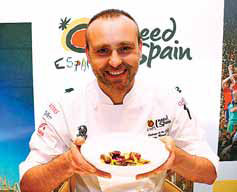Botany on the table
Updated: 2013-03-31 07:39
By Ye Jun (China Daily)
|
||||||||
|
Spanish chef Rodrigo de la Calle is known for introducing rare plants and flowers into his dishes in a concept widely known as gastrobotany. Provided to China Daily |
Spanish chef Rodrigo de la Calle says when people pass a florist's shop, they would be thinking of a bouquet for their beloved, but for him, he would be pondering how many of the flowers and leaves in there he could include in a dish.
The Michelin recognized chef is known for introducing rare plants and flowers into his dishes in a concept widely known as gastrobotany, and he was in China recently to tell diners what it was all about, at the invitation of the Ritz-Carlton Beijing's Barolo Restaurant.
De la Calle loves plants so much he has tattoos of them on his arm and on his back, and his botanical connection starts right at home with a father who is a farmer, and a mother who is a chef.
It extends to marital ties as well, with a mother-in-law who came to China to study traditional Chinese medicine with its wide pharmacopeia of plants and herbs. In fact, she tells De la Calle that his element is wood and he should eat more artichoke and endives.
At 36, De la Calle has already been cooking for 18 years, and he started work as a chef in 2000. In these years, he worked in 36 restaurants in nine cities in Spain, before finally opening his own restaurant in the small town of Aranjuez, a little south of Madrid. His namesake restaurant was awarded its first Michelin star in 2011.
An encounter with Santiago Orts, a botanist, when he was working at La Taula del Hotel Milenio restaurant in Elche, a small town in eastern Spain changed the way De la Calle looked at ingredients and inspired his "gastrobotany" cuisine.
The chef thinks it is timely, for as sophisticated diners turn more and more to vegetable dishes, he is ready with his plant specialties at the restaurant.
De La Calle claims two major influences in his cooking style. One of them is Andoni L. Aduriz, whose restaurant Mugaritz has two Michelin stars. Aduriz uses only herbs, flowers and vegetables for his dishes. Another is Martin Berasategui, whose restaurant has three Michelin stars, and who uses ordinary ingredients to create extraordinary dishes.
Although De la Calle himself eats only small amounts of meat and fish, he is not a vegetarian and he does not think he would become one. In a small town like Aranjuez with only about 25,000 residents, a purely vegetarian restaurant may not survive, he says.
He thinks Ferran Adria is a milestone in Spanish cooking. If there is a book about Spanish cooking, it should be divided into "before Ferran" and "after Ferran", he says. But, although he thinks Adria is very influential, the chef thinks there are many who also cook like him.
"Each chef is unique, because they will do what they want to do, and have their own specialties, be it seafood, or vegetables," he says.
As for himself, De la Calle believes the chef's emotion is infused into the food. Guests can tell if the chef is happy or sad.
"The best food in the world is the food that the chef treats well," De la Calle believes, and at his restaurant, his staff members are constantly reminded: "When you serve food to the customer, you should think the dish is to be served to your own mother. When you take it away, you should think 'what a shame this dish is not for me'."
De la Calle has been traveling around the world telling people about gastrobotanical cuisine in the last four years, and making converts. However, he is still very down to earth.
"When I first started cooking, Michelin star chefs were like football celebrities to me," he says. "Sometimes I still don't believe I'm one myself now, and I need to pinch myself to make sure I'm not dreaming."
He still has dreams, and his ambition is to "one day open a restaurant in China and make a lot of money. Then I will consider myself successful".
yejun@chinadaily.com.cn

 'Taken 2' grabs movie box office crown
'Taken 2' grabs movie box office crown
 Rihanna's 'Diamonds' tops UK pop chart
Rihanna's 'Diamonds' tops UK pop chart
 Fans get look at vintage Rolling Stones
Fans get look at vintage Rolling Stones
 Celebrities attend Power of Women event
Celebrities attend Power of Women event
 Ang Lee breaks 'every rule' to make unlikely new Life of Pi film
Ang Lee breaks 'every rule' to make unlikely new Life of Pi film
 Rihanna almost thrown out of nightclub
Rihanna almost thrown out of nightclub
 'Dark Knight' wins weekend box office
'Dark Knight' wins weekend box office
 'Total Recall' stars gather in Beverly Hills
'Total Recall' stars gather in Beverly Hills
Most Viewed
Editor's Picks

|

|

|

|

|

|
Today's Top News
Boston bombing suspect reported cornered on boat
7.0-magnitude quake hits Sichuan
Cross-talk artist helps to spread the word
'Green' awareness levels drop in Beijing
Palace Museum spruces up
First couple on Time's list of most influential
H7N9 flu transmission studied
Trading channels 'need to broaden'
US Weekly

|

|








